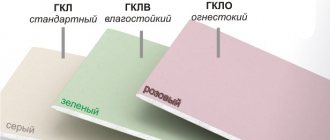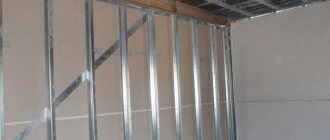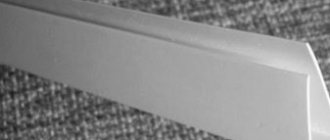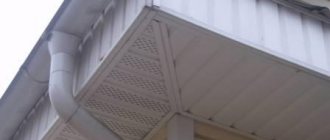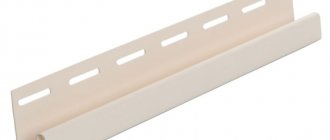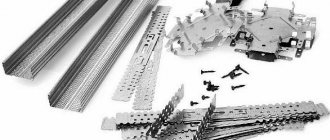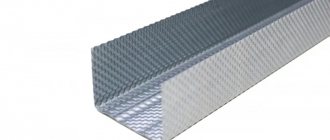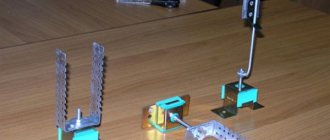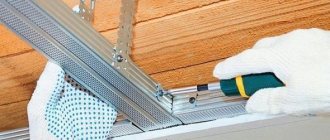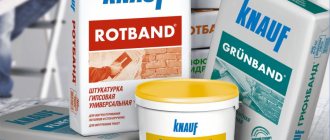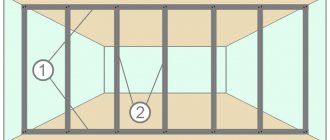What kind of plasterboard profiles can there be?
In 1980, a paper mill owner named Ostug Sackett had the idea of creating a new building material from gypsum. At first, plasterboard sheets replaced plywood and chipboard in small houses. It was then that the interesting properties of this material were discovered. The joints of smooth and even cardboard are very easy to seal so that when painting or other types of finishing, they will be completely invisible. Breaking a marked sheet instead of sawing it is much easier. Constancy of dimensions eliminates cracks in joints... Drywall has proven itself in the construction market for a long time and has remained an integral part of repairs to this day.
This or that plasterboard structure must be supported by a frame made of strong and stable parts. These are guides and profiles of various shapes, which are connected to each other using special fasteners. They differ in purpose and application, as well as in size and quality. It is very important to make the right choice when purchasing, the result of the work will depend on it. After all, if you take a bad or simply unsuitable profile for a certain type of work, the design will eventually have to be redone. For example, a sheet on a partition will bend or “move” to the side, gaps at the joints will become visible, or a noticeable “wave” will appear on the wall itself. In order to avoid mistakes during repair and construction, you need to thoroughly study the types and sizes of drywall profiles. Find out exactly what material is needed to build a particular structure.
Tools required for cutting and processing gypsum boards
There are a number of tools and devices that are used for cutting and processing plasterboard sheets.
Cutting table
This device consists of two support legs with thrust elements attached to them. There is a lattice cover on top, on one side of which a pressure ruler of the appropriate length is fixed using special clamps.
Folding workbench
An equally convenient device, the main difference of which is the removable cover, which allows, if necessary, to fold the support frame for subsequent transportation. For this purpose, special loops are designed, which are located on the end crossbars.
The material is cut using a construction knife or a cutting tool designed directly for drywall.
Narrow cutter
The device is necessary so that it is possible to cut a strip from a full-size sheet, the width of which does not exceed 120 mm. This cutting is carried out by two discs that simultaneously cut the material on both sides. Some models of such devices are equipped with an additional handle, which makes them more convenient to use.
Wide cutter
Works on the same principle, but is used to cut larger pieces of drywall. The permissible limit for sheet width in this case is 630 mm. At the same time, cutting with a regular knife gives almost the same results, which explains the rather low demand for such devices.
Hand saw
To create rectangular holes or elements with complex shapes, you will need a hacksaw with a minimum blade width and fine teeth. Such tools are made specifically for working with gypsum boards.
Roughing plane
The tool is a type of rasp with which the edges of cut sheets are processed, which allows you to align them and achieve ideal smoothness. The tool involves the use of replaceable blades, the installation of which is carried out by loosening and tightening the tension screw.
Edge plane
An edge cutter is used to trim the edges of edges to create chamfers. In this case, the angle of inclination can be 22.5 or 45 degrees. Before using the edger, the ends of the sheet must be leveled using a roughing plane.
Circular cutter
A special attachment for a drill allows you to make standard holes in drywall necessary for installing all kinds of communication elements. Such products are mainly sold in sets and have different diameters, which makes it possible to choose a cutter for a specific purpose.
Ballerina for gypsum boards
This tool also creates holes. In this case, their variable diameter is assumed, which can vary in the range of 12-320 mm. The device consists of an aluminum body and a particularly durable cutting element in the form of a roller made of carbide materials.
Needle roller
This device is used exclusively in cases where it is necessary to give the material an arched shape or create another type of curved surface. Water is applied to the plasterboard sheet, which, during the perforation process, penetrates directly into the body of the gypsum layer. The depth of the holes is 5-7 mm, and their diameter ranges from 2-3 mm. In this case, the side on which the recesses are made should be concave.
Metal scissors
The tool will be needed during the profile cutting process. This is an excellent alternative to a hacksaw, which is not always convenient to work with in certain conditions.
Power tools
These primarily include an angle grinder and a jigsaw, which can, in some cases, significantly simplify the work. Small electric scissors will also come in handy, allowing you to reach hard-to-reach places.
Ceiling profile for plasterboard. Sizes and types.
Rack profile (designated as: CD or PP).
Perhaps one of the most popular profiles for installing plasterboard on the ceiling. This type provides reliable fastening of the sheets. And if you choose the dimensions correctly, the work space will be used as economically as possible, leaving almost no waste.
CD or PP sizes:
- Profile length - from 2.5 to 4 meters
- Width – 60 millimeters
- Shelf height – 27-28 millimeters
Guide (UD or PPN).
Profiles are used for the construction of suspended ceilings. These elements are mounted over the entire area of the work, because when securing sheets of cardboard, the drill passes directly through them. It is advisable to purchase guides that already have cut holes (perforated profiles). Then it will be much easier to carry out installation.
Dimensions:
- Thickness – 0.55 millimeters
- Length – 3 meters
- Width – 27 millimeters
- Height – 28 millimeters
Profile (UW).
This type is very similar to the UD described above. It is used in the same way, but has different dimensions:
- Length – from 3 to 4 meters
- Width from 5 to 10 centimeters
- Shelf height – 40 millimeters
- Metal thickness – from 0.4 to 0.6 millimeters
The main component of the metal frame
The basis of any frame structure is a steel element, which can have different shapes depending on its purpose; it is used for fastening gypsum board sheets at various stages of repair. There are several types of profiles for drywall:
1 — guide profile; 2 - rack profile; 3 - ceiling profile; 4 - ceiling guide profile
- Guide PN. High quality galvanized steel is used for production. The shape of the element is made in the form of the letter “P” and it is the basis for attaching rack profiles. Section: 50x40, 65x40, 75x40 and 100x40 mm. The length of the standard PN is 3000 mm, 6000 mm can be made upon request.
- Rack PS. It is usually made on the basis of a thin steel strip, has the shape of the letter “C” and is used in conjunction with a guide profile. Section: 50x50, 65x50, 75x50 and 100x50 mm. Length: 3000, 3500, 4000 mm. For the convenience of installing partitions with your own hands, such a profile is simply irreplaceable.
- Ceiling PP. Will be needed for installation of ceiling structures. It has the form of a channel and is made only from high quality galvanized steel. Equipped with three grooves and has a cross-section - 60x27 mm, length - 3000 mm.
- Ceiling guide PN. When installing a suspended ceiling, it is attached to the wall and serves as guides for the PP. Section - 28x27, length - 3000 mm.
- Corner (defensive). Necessary for processing the ends of walls. Section depending on type: 25x25x0.4, 31x31x0.4 and 31x31x0.5. Length – 3000 mm.
1 — corner protective profile; 2 – corner plaster profile
Corner (plaster). It has a similar purpose to the protective one, but has a different cross-section (35x35 mm). Flexible arched profile for plasterboard. Made from thin, high-quality steel with special holes for putty penetration. The maximum bending radius is 500 mm for a concave element and 1000 mm for a curved element. The length varies from 3000 to 6000 mm. Mayachkovy. Used as a base element in the plastering process.
1 - flexible arched profile for gypsum boards; 2 — beacon profile; 3 - reinforced profile
Reinforced profile for plasterboard. Most often it is used for installing gypsum boards in doorways, but can also be successfully used in the construction of interior partitions. The thickness of such a profile for plasterboard is 2 mm, which significantly increases the reliability of the future structure. Section: 50x40, 75x40 and 100x40 mm. Length – 3000 mm.
Above are all existing types of metal profiles for gypsum plasterboards. Now it’s time to decide how to choose them correctly and use them in construction.
Arched profile (PA) for drywall. Sizes and types.
This profile has cuts along the edges, thanks to which the metal product can be evenly bent and adapted to the construction of almost any complex structure. For example, make an arch or shelf in the wall of an unusual shape. There are both concave and curved types of arched profiles.
Dimensions of concave arched profiles:
- Radius from 500 to 5000 millimeters
- Length from 2600 to 4000 millimeters
Convex profiles can be:
- Radius from 1000 to 5000 millimeters
- Length from 400 to 2600 millimeters
Aluminum and galvanized profile for plasterboard. Sizes and types.
Profiles for drywall are made from different metals; let’s look at the most common types: aluminum and galvanized, as well as their characteristics.
Aluminum profile and its features.
This profile is not cheap, but it has excellent characteristics, so the high price is justified. Such profiles are good for constructing window frames or finishing household appliances. For example, if you need to make a niche for a washing machine in the bathroom. This product is distinguished by its long service life, durability and lightness. It does not weigh down the entire structure and is very easy to install. Plastic and resistant even to low temperatures. Builders recommend buying aluminum profiles for wall and ceiling cladding.
Profiles of this type are available in both cold and warm aluminum. Cold-formed is made of metal 4 millimeters thick, and bends without heating. It varies in shape (P, W, T, H - shaped). Withstands loads of up to 1.5 kN per 1 meter of wall.
Galvanized profile.
A galvanized profile is not inferior in price to an aluminum one. It is used to construct the base of the frame in rooms with high humidity - in the kitchen or bathroom. This is because it is resistant to rust and does not require additional treatment with anti-corrosion agents. Like aluminum, the profile is light and soft; screwing self-tapping screws into it will not be difficult. Galvanization is also used to create additional stiffeners if the plasterboard sheets are thicker than 12.5 millimeters.
There is also a plastic profile. Its purpose is to cover the joints of plasterboard sheets at the outer corners, giving a beautiful finish. And also, they cover the transition of drywall and other materials, for example, wood.
Material
The profile for plasterboard is made of two metals:
- aluminum;
- steel.
Aluminum profiles have excellent technical characteristics, but their cost is significantly higher than that of metal ones. For this reason, metal profiles for drywall are most common. In turn, it can be with or without a protective coating. As a rule, galvanization is used as a protective coating.
It is worth considering that a profile without a protective layer is used in rooms without the presence of an aggressive environment. In damp places or in the presence of other factors that can accelerate metal corrosion, a zinc-coated profile is used.
Additional accessories for fixing drywall.
In order to assemble the sheathing, you will need auxiliary parts:
- Two-level connector for CD profile. This part is sold in an unfolded, flat form and before starting work it needs to be bent in the shape of the letter P. It is used to connect rack-mount parts perpendicular to each other.
- Single-level connector for CD profile or “Crab”. They connect perpendicular CD profiles in exactly the same way. If the load is more than 20 kilograms, then you will need two self-tapping screws for fastening. Otherwise, the seals are simply bent.
- Direct suspension for a rack (supporting) profile. This is a bracket, the standard length of which is 12.5 cm. It looks like a strip of aluminum or galvanized steel with holes. Withstands loads up to 40 kilograms. It is attached to the wall with two dowel nails, then the edges are bent and the frame parts are already attached to them.
- Anchor suspension for ceiling carriers. Often called suspension with traction. Replaces the part described above if it is not long enough. Used on horizontal surfaces, for ceilings, for example.
- Extension. Needed to connect two carriers to each other. It has tubercles on the sides, this indicates where the profile joins. There are also two holes for screwing in self-tapping screws.
- Corner connector. It connects elements that do not form a cross. You can do without a connector. Cut the flanges of the profile that needs to be connected so that a tongue is formed, and screw it in place with self-tapping screws.
What is a metal profile
Frame profiles are thin metal products made from galvanized sheet, cold rolled, aluminum or plastic.
They usually have a T-, L- or U-shape with cavities. There are profiles for drywall:
- Angular;
- Flat;
- In the form of a channel.
They are used as load-bearing elements for gypsum plasterboards when:
- Creation of level ceilings;
- strengthening plasterboard edges;
- formation of the “skeleton” of curved structures, arches;
- installation of partitions;
- covering walls and ceilings with significant differences in the surface;
- internal wall or ceiling insulation, sound insulation
The quality of all types of profiles for plasterboard is established by GOST and TU standards.
A huge number of companies are engaged in the production of long lengths, in particular such well-known ones as Knauf and Giprok.
There are many varieties of metal profiles, which are very important to understand and be able to choose them correctly, otherwise, when installing “from whatever,” you end up with an uneven, fragile surface, or, on the contrary, an unreasonably hard and excessively expensive surface.
Accessories for fastening plasterboard.
Self-tapping screws are needed to connect all the frame parts and to install drywall. They also come in different types.
- Self-tapping screws LB9 (11, 16) and LN9 (11, 16). The numbers after the name indicate the length of the screw. Type LB is drilling, and LN is piercing. Builders call this type of product “bugs.” These “bugs” have a convex cap, and this prevents the drywall from fitting tightly to the frame.
- Self-tapping screws TN25. These screws are used to attach the sheets to the profiles. They have a flat cap so that when priming the wall, it can be easily hidden. There are also long self-tapping screws of this type; they are needed if, to increase strength, you need to screw two sheets at once.
- Self-tapping screws with press washer. Suitable for working with any materials. They can be either drilling or piercing types. Length from 9 millimeters to 10 centimeters.
- Self-tapping screws with dowels. The guides are attached to the enclosing structures. The range of these elements is large; which one to choose depends on the material of the ceiling or wall and the size of the profile.
- Ceiling wedge anchor. This fittings are used to attach anchor suspensions to the ceiling.
- Dowel nail. Product lengths range from 40 to 60 millimeters. Used to secure the frame to a brick or concrete wall. To make this easier, you can hammer the screws in instead of screwing them in.
Tips on how to choose a profile and components for drywall.
- Please inspect the profile carefully before purchasing. If you notice rust, you should refuse to buy such material. Once corrosion has already begun, it is impossible to stop it!
- Check the thickness using a caliper. If it turns out to be insufficient, then during operation the screws will scroll.
- Do not take a profile with burrs. In the process of work, injure your hands.
- Take a closer look at the product from the end. If it was not stored correctly in the store, it may be bent. With such a profile, you will no longer be able to create a perfectly flat surface of the structure.
- Keep in mind that it will be difficult to screw self-tapping screws into a profile with a weak notch.
- Experienced builders advise double-checking whether the dimensions correspond to those stated in the instructions and in reality. Some manufacturers deceive buyers, especially regarding the length; it may be less than expected, by 2 centimeters.
- The quality of fastening fittings should also be checked. Very often you come across self-tapping screws with a broken tip or with screwdriver notches clogged with metal.
- Carefully inspect the plastic plugs of the dowels so that there are no sagging, otherwise it will be difficult to drive them into the hole, and sometimes even impossible.
- Give preference, however, to a profile with dot perforations along the strip - it is more rigid and resistant to loads. This structure prevents the screws from slipping and makes it possible to screw them in at any angle.
- Trust already proven manufacturing companies such as Knauf and Gyprok. But there are also our domestic manufacturers who produce profiles for drywall no worse.
- Some cunning sellers try to hide defects by painting the profile and adding shine to it. Take a closer look at these options; you may not be able to buy them at all.
- The product should not be flimsy and bend when pressed lightly.
And one last piece of advice at the end of the article. Do not skimp on high-quality profiles and components for them. As the famous saying goes: “The miser pays twice.” If you purchase a low-quality or damaged profile, then eventually, sooner or later, you will have to redo all the work. Somewhere the sheet will become a “bump”, somewhere the joints will become visible, and somewhere the structure will bend inward. Therefore, choose the material carefully; pickiness will not be superfluous here. Good luck and easy work!
Guide
The guide profile (marked PN) has a cross-section similar to a rack, that is, with a channel. It is used as the basis for the rack profile.
In addition, it is used to create jumpers between profiles (for example, for fastening door frames in partitions).
PN 40-50 in section
Characteristics
The back of this profile is equipped with two stiffening ribs.
The following varieties exist:
Where the first value is the width of the profile, and the second is the backrest (by analogy with rack-mounted samples).
The backs of the profile have holes 8 mm in diameter, which are needed for installing dowels that provide fastening to the base. Due to the fact that the width of the shelf of this profile is 40 mm, it is possible to fix gypsum board sheets directly to it.
To create external corner joints, corner types of guides for drywall (PU) are used. They are designed to protect the ends of the partitions from various mechanical damages during operation.
Characteristics
Due to the fact that the shelves of this profile are located at a mutual angle of 85 degrees, reliable fixation to the partitions is ensured. Holes with a diameter of 5 mm are made in the guide shelves, which are filled with putty during installation.
PU profile fastening diagram
To make curved structures from gypsum plasterboard panels, a special arched profile is used. It is made from ceiling PPP 27-60, and the bending radius can reach 500 mm.
The manufacture of such structures is a rather complex process, so we present to your attention a tutorial at the end of this article, which is designed to reveal all the nuances of this operation (see also how to make an arch from plasterboard.
The beacon profile is used as a supporting guide for further plastering of the surface. Its length can be no more than three meters. The need for such a profile arises when finishing slopes and other surfaces that require perfect smoothness.
Tip: if necessary, you can connect several elements into one using special fasteners. The profiles will be plastered in the future, so the joints will not be visible.
Application
Of course, the main requirement for any surface is smoothness.
This is especially true for slopes, because they primarily attract attention (see also finishing slopes with plasterboard with your own hands)
In order to align these elements, a lot of effort is required.
This simple element can make a master’s life much easier
However, modern technologies have made it possible to significantly speed up this process. In particular, a beacon profile was created, which eliminates the need for a person to make platonic efforts to plaster slopes. It is applied to the “problem” area, thereby simplifying the alignment process.
Peculiarities
Several important features of this profile should be noted:
- This profile is made of thin steel, which is subsequently coated with zinc. This measure makes it possible to give the element high resistance to many negative environmental influences.
- Due to the chemical properties of zinc, the PM profile is not at all “afraid” of alkalis and acids. Such a wonderful property is difficult to overestimate, because modern construction is inextricably linked with the use of various carcinogenic substances, which carry serious destructive power.
- In most cases, this type of guide is available in a length of 3 meters. However, many modern manufacturers allow their customers to purchase products for individual orders.
Beacon profile in person
The thickness of this profile can vary from 6 to 10 mm. It is worth understanding that the larger it is, the higher the rigidity of the element
It is important to correctly assess the scope of work in order to acquire the profile of the required rigidity (for example, for curved surfaces it is better to use samples with the smallest thickness)
According to many experts, this particular type of guide is the most difficult to attach. Therefore, before starting work, you need to stock up on a laser level, and most importantly, patience.

